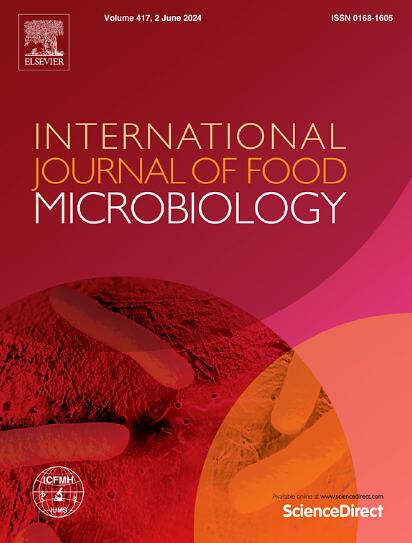新鲜农产品中单核增生李斯特菌生物膜形成能力的潜在遗传标记
IF 5.2
1区 农林科学
Q1 FOOD SCIENCE & TECHNOLOGY
International journal of food microbiology
Pub Date : 2025-02-18
DOI:10.1016/j.ijfoodmicro.2025.111118
引用次数: 0
摘要
单核增生李斯特菌形成生物膜的能力是其在食品工业中持续存在的关键。生物膜表型评估主要基于物理和化学方法,耗时较长。本研究的目的是分析单核增生乳杆菌生物膜形成能力的遗传差异,发现潜在的遗传标记,并快速确定生物膜表型。通过多位点序列分型和生物膜形成试验,对103株农产品产单核增生乳杆菌进行了鉴定。采用比较基因组学分析了12株代表性菌株的遗传特征,并采用聚合酶链反应技术对103株菌株的相关遗传特征进行了验证。103株菌株共分为22个序列型(STs),根据生物膜生物量中位数从高到低依次为:ST91、ST87、ST8、ST9、ST121、ST155,均表现出2-3种生物膜表型(强、中、弱)。通过比较基因组学分析和验证,vip基因可作为生物膜表型的初步遗传标记,通过将vip与1-3个基因(smrmb、cycB、uvrB)或STs (ST8、ST87、ST121)结合,可提高测定的准确性。此外,smc_4、srmB-inlH、inlH和ssbA基因可以准确区分ST9、ST155、ST91等STs的表型。这些遗传标记可作为快速测定单核增生乳杆菌生物膜表型的关键靶点,从而为食品工业消毒工艺的优化提供有益的指导。本文章由计算机程序翻译,如有差异,请以英文原文为准。
Potential genetic markers of biofilm formation ability by Listeria monocytogenes isolated from fresh agricultural products
The ability of Listeria monocytogenes to form biofilms is the key to its persistence in the food industry. Biofilm phenotype assessment is mainly based on physical and chemical methods, which are time-consuming. The aim of this study was to analyze genetic differences in the biofilm-forming ability of L. monocytogenes, found potential genetic markers, and quickly determined the biofilm phenotype. In particular, 103 strains of L. monocytogenes from agricultural products, were evaluated through multilocus sequence typing and their biofilm formation assays. The genetic characteristics of 12 representative strains were analyzed by comparative genomics, and the relevant genetic characteristics of the 103 strains were verified by polymerase chain reaction technology. The 103 strains were divided into 22 sequence types (STs), and top six types were ranked from high to low according to the median of biofilm biomass as follows: ST91, ST87, ST8, ST9, ST121, ST155, and all of them exhibited 2–3 biofilm phenotypes (strong, medium and weak). Comparative genomics analysis and verification identified the vip gene as a preliminary genetic marker for biofilm phenotypes, and the accuracy of determination can be improved by combining vip with 1–3 genes (srmB, cycB, and uvrB) or STs (ST8, ST87, and ST121). In addition, the smc_4, srmB-inlH, inlH and ssbA genes could accurately distinguish the phenotypes of ST9, ST155, ST91 and other STs. These genetic markers could be used as key targets for rapid determination of the biofilm phenotype of L. monocytogenes, thereby providing useful guidance for the optimization of disinfection processes in the food industry.
求助全文
通过发布文献求助,成功后即可免费获取论文全文。
去求助
来源期刊
CiteScore
10.40
自引率
5.60%
发文量
322
审稿时长
65 days
期刊介绍:
The International Journal of Food Microbiology publishes papers dealing with all aspects of food microbiology. Articles must present information that is novel, has high impact and interest, and is of high scientific quality. They should provide scientific or technological advancement in the specific field of interest of the journal and enhance its strong international reputation. Preliminary or confirmatory results as well as contributions not strictly related to food microbiology will not be considered for publication.

 求助内容:
求助内容: 应助结果提醒方式:
应助结果提醒方式:


